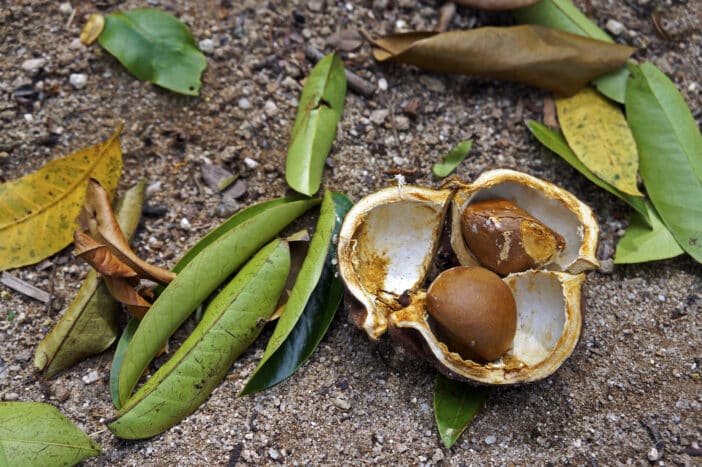Andiroba Oil
Common in the tropical zones of South America and especially in the Brazilian Amazon basin, including flooded areas, the andiroba tree belongs to the Meliaceae family, like the mahogany and cedar trees. Other names suggest its relationship to mahogany: Bastard Mahogany, Brazilian Mahogany or Paramahogany. The versatile andiroba oil is extracted from the tree’s seeds.
The Andiroba tree reaches a height of up to 50 meters with a trunk diameter of one to two meters. The young trees have taproots, while in older trees the superficial board roots become more pronounced. The brown-gray capsule fruits, 6-12 cm in diameter, grow in clusters. Inside are two to four nut-like seeds. The fruits disperse the seeds by falling into the river at tree sites near water and being carried on. They are collected by locals to take advantage of the valuable ingredients.
The Andiroba tree is named after its essential ingredients. In the language of the Indians it means: nhandi = oil and rob = bitter.
Use: from folk medicine to shipbuilding
In folk medicine, the oil is used to relieve pain and inflammation, to rub on sprains, arthritis or rheumatism. Mixed with honey, it helps with sore throats and flu-like infections. The tea from the bark is drunk against fever and worms.
For protection against parasites, the oil has a long tradition and proves useful for driving away mosquitoes. When burned in candles, it keeps away malaria, yellow fever or dengue fever transmitting insects without emitting toxic smoke.
The wood has high resistance to insect damage and was therefore also used as construction timber and for shipbuilding. Today it is mostly used in the furniture industry as veneer or plywood.
Due to its density, it is also suitable for the production of biodiesel.
The great demand for the versatile andiroba oil also brings disadvantages.
What are the disadvantages?
The disadvantages are not related to the fruit itself, but result from excessive exploitation. In many places, the high demand leads to monocultures whose plants are more susceptible to pests. Illegal removal of trees from the Amazon rainforest has also increased.
It is therefore important that both manufacturers and end consumers pay attention to sustainable sources, transparent supply chains, fair trade and appropriate certifications (e.g. Organico Brasil, USDA Organic, Ecocert, COSMOS, Bio-Label). This is the only way to guarantee the purity and active ingredient density of the oil, which are particularly relevant in terms of pharmaceutical and cosmetic properties.
Care ensures quality and this also depends on the procedures of oil extraction from the seeds. An andiroba oil tree yields about 120 fruits per year and 8 – 22 liters of oil, depending on the extraction method. In the traditional gentle method, 12 kg of seeds yield 1 liter of oil. When extracting with chemical solvents, 3 kg of seeds are sufficient for 1 liter of oil. Careful cold pressing is as relevant to quality as is collection. For good quality, the fruits are collected immediately after harvest or on the river bank, broken open by hand and inspected to sort out maggot-infested fruits before cold pressing. Only in this way can the high density of active ingredients in the seeds also be found in the oil. If the oil is not absolutely pure, the sensitive skin that benefits from good cosmetic quality andiroba oil can become irritated.
Valuable andiroba oil for pharmacy and cosmetics
Andiroba fruit contains mainly fatty acids and bitter substances.
Fatty acids: oleic acid (51%), palmitic acid, palmitoic acid, stearic acid, linoleic acid, linolenic acid, omega-9 and -6
Bitter content: triterpenes, tannins, limonoids, alpha-hydroxy acids
The high content of fatty acids makes andiroba oil interesting for cosmetics. The fats have an affinity for the skin, are similar to skin lipids and are suitable for strengthening and repairing the skin barrier. They are ideal for sensitive and dry skin. In addition, omega 6 and 9 fatty acids have anti-inflammatory and cell-protective properties. The bitter compounds contained in mahogany plants, such as andiroba oil, have a potential for skin care that has only recently been deciphered and exploited.
Andiroba oil against biting insects
Plant bitter substances belong chemically to different groups of substances. In the Andiroba tree, especially in the seeds, the so-called limonoids are contained. They have antibacterial and insecticidal effects, and their pharmaceutical action against malaria and leishmaniasis has been demonstrated. Of the limonoids in Andiroba seeds, andirobin in particular is responsible for the anti-inflammatory and insect repellent effects.
As insect repellents, Andiroba products can be applied directly to the skin and protect very efficiently.
Idea: Andiroba oil as a natural denaturant
In addition, Andiroba extract with its bitter components can make cosmetic products unpalatable and is therefore used for denaturation/denaturing, especially ethyl alcohol.
No microplastic scrub from the shells
Andiroba seeds are suitable as abrasive particles, whether in shower gels, soaps, scalp care products, facial cleansers, hand and foot care or massage products. They are a 100% natural, biodegradable alternative to polyethylene granules.
Effect of andiroba oil in cosmetics
Studies have shown that limonoids promote the formation of keratinocytes and filaggrin, strengthen the skin barrier and inhibit stress-induced lipid peroxidation.
Andiroba seed surprises with its content of α-hydroxy acids, which have a moisture-regulating effect, promote cell metabolism and desquamation of the skin, stimulate collagen formation and can lighten superficial pigment spots. Due to the combination of α-hydroxy acids with the anti-inflammatory bitter substances and astringent tannins, andiroba oil lends itself to preventive anti-cellulite care. The anti-cellulite effect is explained by blocking enzymes involved in cellulite formation and the anti-inflammatory properties.
The anti-inflammatory effects of andiroba oil are also used in soaps and lotions to treat acne and pimples and to care for skin that is easily inflamed or irritated. The oil relaxes the skin, is ideal for the care of dry, cracked, aging skin. It also strengthens hair and gives a fine shine to skin and hair.
Triple A – natural remedy for blemished skin/acne
At the manufacturer Beraca, which offers high-quality components from the Brazilian rainforest for cosmetics, we found some interesting combinations of active ingredients with andiroba oil:
– A complex of andiroba oil, copaíba and açaí for use in products for skin care.
– For oily and acne-prone skin
– After 56 days of use, there was a 43% decrease in skin blemishes
Fact Sheet: Andiroba oil
INCI: Carapa Guaianensis Seed Oil
CAS No.: 352458-32-3
Description: light yellow oil, bitter taste
Origin: Brazil
Production: cold pressing
Components: Fatty acids (oleic acid, palmitic acid, palmitoic acid, stearic acid, linoleic acid, linolenic acid, omega-9 and -6), bitter compounds, alpha hydroxy acids.
Effects: anti-inflammatory, moisturizing, insect repellent, gives shine, absorbs quickly into the skin
Use: care products for sensitive, impure, dry skin, denaturant
We like to work with the following andiroba-containing active ingredients:
| Trade Name | Comany Name | INCI | Comment |
|---|---|---|---|
| Andiroba Oil | Citróleo | Carapa Guianensis Seed Oil | |
| Andiroba Natural Scrub | Beraca - a Clariant Group Company | Carapa Guianensis Seed Powder | |
| Refined Andiroba Oil - BCE1069 | Biocosmethic | Carapa Guianensis Seed Oil | |
| Organic Andiroba Oil | Beraca - a Clariant Group Company | Carapa Guianensis Seed Oil | |
| Biochemica Andiroba Oil NAT | Hallstar | Carapa Guianensis Seed Oil | |
| Andiroba Oil | 100% Amazonia | Carapa Guianensis Seed Oil | |
| Andiroba Oil | Laboratoires Expanscience | Carapa Guianensis Seed Oil | |
| Andiroba Oil | Inzunai | Carapa Guianensis Seed Oil | |
| Andiroba Oil | Beraca - a Clariant Group Company | Carapa Guianensis Seed Oil | |
| Organic Andiroba Oil | 100% Amazonia | Carapa Guianensis Seed Oil | |
| ANTI-ACNE - BERACARE TRIPLE A SYSTEM | Beraca - a Clariant Group Company | Copaifera Officinalis (Balsam Copaiba) Resin, Carapa Guianensis Seed Oil, Euterpe Oleracea Fruit Oil |
Andiroba oil in high quality cosmetics
Andiroba oil can be used for hand care, in cleansing oils/masks, for lip care, in moisturizing products, anti-cellulite creams, body lotions/creams, massage oils, for the care of inflamed, irritated skin and as a mosquito repellent for the skin. Andiroba oil uniquely combines nourishing and restorative fatty acids, anti-inflammatory and protective bitter substances, and skin-renewing α-hydroxy acids. It is suitable for sophisticated cosmetics and natural cosmetics with the appropriate certifications and appeals to people who pay attention to ethically and ecologically conscious cosmetics.
Cosmacon will be happy to advise you on the formulation of exquisite andiroba oil products.
Sources:
Antioxidant Activity and Genotoxic Assessment of Crabwood (Andiroba, Carapa guianensis Aublet) Seed Oils.; Oxid Med Cell Longev. 2018 May 2;2018:3246719.

